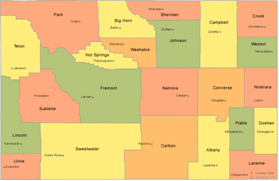Early Wyoming County History

The two first white persons whose names were closest connected with the settlement of the region which is now known as Wyoming County were a woman and a man. The woman was noted, the man notorious. Dehewamis, or Mary Jemison, who was called by the Senecas simply “the white woman,” was a resident of the Genesee Valley for seventy-two years, fifty-two of which were lived at Gardeau Flats, in the town of Castile, Wyoming. Captured by the Indians in 1755, she was adopted by two Seneca women, and later married a Delaware. In 1759 she came to Genisneyo and, for a time, she stayed at Little Beard’s town, a large Indian village near where Cuylerville is now located, but after its destruction by Sullivan in 1779, she came to live on the Flats, called in the Seneca, “Kautam,” or in the English, “Gardeau.”
Later she became known and respected by the whites, although she would not desert her Indian friends who loved her. She died in 1833 at the age of ninety or ninety-one. In the treaty made by the Senecas with Robert Morris in 1797, they reserved for Mary Jemison a tract of 17,927 acres, the most of which was located in the future town of Castile. Upon this tract she lived with her descendants until 1816, when she sold all but two square miles on the west side of the river to Micah Brooks and Jellis Clute. The remaining land was purchased in I83I by Henry Gibson and Jellis Clute. Aside from this tract, the most of the land in the county were parts of the Morris reservation and the Holland purchase.
The first white man to live within the boundaries of the county was Ebenezer Allen, called at the time “Indian Allen,” a tory, who, towards the close of the Revolution, made his home at the house of Mary Jemison for whom he farmed until 1783. He was a “swindler, a polygamist, an adulterer and murderer, one of the foulest characters of his day.” He later built a saw and gristmill on the site of Rochester, and eventually fled into Canada. With the exception of Mary Jemison and Indian Allen, the first settlers of the district came in 1802, John Tolles, Jacob Wright, Nathaniel Sprout, and Stephen Crow. They were quickly followed by others, and in a few years the finest lands had been taken. The early settlers were from New England for the most part, but those who came Iater were preponderantly German.
Wyoming is one of the western counties, centrally located south of Genesee, with only Erie County separating it from Lake Erie. The Genesee River forms a part of the east boundary, where it runs through deep cliffs, 200 to 400 feet high. There are many streams draining the section, which partakes of the nature of a broad rolling upland. The land is fertile, but varies greatly, for it is for the most part made up of glacial drift, which in turn has made many natural dams forming lakes and low lands where there is a muck soil or marl. The county is almost wholly an agricultural section, with grains, hay and dairying as the main form of farming, although there are heavy plantings of fruit trees and in some parts vegetables, particularly potatoes, are the main crops.
The organization of the county was not completed until May 14, 1841, when the southern half of Genesee was erected as Wyoming County, with Warsaw chosen as the shiretown. County buildings were erected the next year at a cost of $12,000. At the time of the erection of the county, horse drawn vehicles were still the only means of transportation, but the Tonawanda and Rochester Railroad was completed to Attica in 1843, and, although there were no more railroads built until nearly ten years later, there was a marked boom in the growth of the county. Many other roads were built in later years, but these years on each side of the date of the organization of the county seem to have been those of the most rapid growth and the coming of the district to maturity. The unsettlement of the Civil War, and the opening of the Western States, caused a check, as it did to all the agricultural sections of the east.

